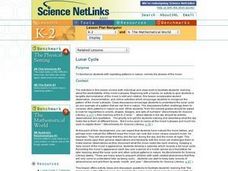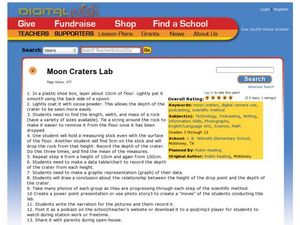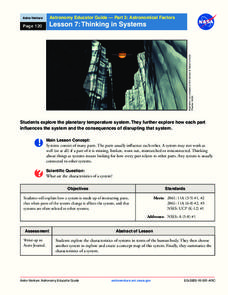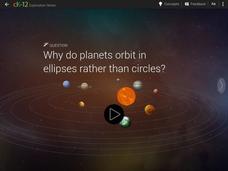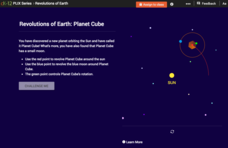Curated OER
Build a Lunar Lander
Students build a space vehicle. In this space lesson, students create a shock-absorbing space vehicle that can be dropped from 1 foot in the air. Their vehicle must include an open cup with two marshmallows (astronauts) that can not fly...
Curated OER
Adding the Moon: Using a Playground Model to Explore the Movement of the Sun, Earth, and Moon
Students experience the rotation of the Earth and the Moon, and the revolution of the Moon around the Earth using a playground model.
Curated OER
Jupiter's Moons
Students predict which of Jupiter's moons will be the "brightest" in infrared wavelengths. Using provided information, they rank the moos from brightes to faintest in infrared.
Curated OER
Finding Jupiter's Moons
Students explore Jupiter's Moons. They calculate and predict the location of Jupiter's 4 large moons. In addition, they draw Jupiter with its moons correctly shown for the time of the observation.
Curated OER
Letters to the Man in the Moon
Students write and communicate mathematically with their classmates. They discuss the mathematics that it took to allow us to conquer space and land on the moon. They sketch a plaque they would leave on the moon.
Curated OER
How Distant is the Moon?--2
Students examine total eclipses of the Sun and their limited regions of totality. They explain that this limited view occurs because the Moon is close enough to us for different points on Earth to view it differently.
Curated OER
Identifying Characteristics of Planets And Their Moon(s) Using an Internet Scavenger Hunt.
Students perform an internet scavenger hunt. They describe characteristics of each planet and their moon(s) and draw a diagram of the solar system and label the planets.
Curated OER
Topsy Turvey Tides
Students explore ocean tides. They research how the sun, moon and earth affect the tides. Students draw a diagram illustrating low tides and high tides. They discuss the affect of gravitational pull on the oceans.
Curated OER
Lunar Cycle
Students become familiar with repeating patterns in nature, namely the phases of the moon.
Curated OER
Prejudice and the Navaho Indian Long Walk
Young scholars read Scott O'Dell's book, Sing Down the Moon, and answer questions about the forced migration of the Navahos from Arizona to Fort Sumter, New Mexico. They conduct research and describe a tenebrae service and its importance.
Curated OER
Do Some Research - Tides
In this science research worksheet, students use the library or Internet to determine what the regular changes in the level of water caused by the moon's gravity is called. They write the answer on the blue line, write a short essay...
Curated OER
Why Does the Moon Have Phases?
In this moon worksheet, students complete the sequence of the different phases of the moon to determine why the moon has phases. This worksheet is a graphic organizer.
Curated OER
Earth, Sun, and Moon
In this identify the part of Earth that is nighttime activity, students view sets of pictures of locations of the sun and Earth and shade in the part of Earth which is in darkness. Students shade 6 pictures.
Curated OER
Moon Craters Lab
Students explore characteristics of mass. In this scientific inquiry about mass lesson, students drop rocks of different weights from various heights and record the depth of the "crater" created. Students record their findings on a...
CK-12 Foundation
Newton's Apple
Scientists state that the higher something is above the earth, the greater the gravitational potential energy. Does this mean there is more gravity acting on the moon than on an apple falling from a tree? Scholars adjust the distance...
Teach Engineering
The Amazing Red Planet
Introduce your class to Mars with a resource that provides information about its size, location, length of day, length of year, number of moons, and average temperature. Also includes is information about the lans for past...
K5 Learning
Miss Mitchell's Comet
Maria Mitchell discovered a comet, became the first female astronomer in the United States, and even has a crater on the moon named after her! Learn more about her passion for the stars with an informative reading passage, followed by...
NASA
Astronomy Mission Module
Yes, scientists say, there is other life in our solar system! And the best place to look is on Europa, a moon of Jupiter. Here, learners mimic the techniques scientists use to gather information about objects in our solar system, write...
Michigan City Area Schools
Goal Setting for Students
Inspire scholars to shoot for the moon with a presentation that details why goals are important, how to define and identify a goal with four essential questions, the difference between dreams and goals, and tips to achieving a goal.
PHET
Pendulum Lab
How would a pendulum work on the moon or Jupiter? To answer that question scholars control up to two pendulums including their location, length, mass, and amplitude. Added controls include changing the friction and strength of gravity....
Laboratory for Atmospheric and Space Physics
Goldilocks and the Three Planets
Venus is the second brightest object in the night sky after the moon. Here is an interesting lesson that explores three planets — Venus, Earth, and Mars — specifically their surfaces and atmospheres. Through an analysis of their spectra,...
McGraw Hill
Gravity Variations Interactive
What would a baseball game look like on the moon? Probably a lot of home runs! A creative activity explores the motion of a projectile on the surface of different bodies in the solar system. Participants adjust the angle and...
CK-12 Foundation
Orbital Motion
Why do planets orbit the sun in ellipses when moons orbit their planet in circles? Pupils control the semi-major axis, eccentricity of the orbit, and position angle. The resulting orbital appears with the related force vectors as...
CK-12 Foundation
Revolutions of Earth: Planet Cube
Does assessing Earth Science vocabulary making your head spin? Test scholars' knowledge of revolving and rotating using an interactive tool. The movement of a new planet and its moon is in their hands, allowing them to explore...
Other popular searches
- Moon Phases
- Phases of the Moon
- Owl Moon
- Moon Landing
- Earth Science Moon Phases
- Moon Phases Worksheets
- Sun and Moon
- Goodnight Moon
- The Moon
- Walk Two Moons
- Earth and Moon
- Earth Moon Sun System










